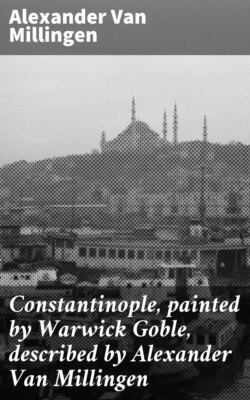Читать книгу Constantinople, painted by Warwick Goble, described by Alexander Van Millingen - Alexander Van Millingen - Страница 7
На сайте Литреса книга снята с продажи.
CHAPTER III the making of constantinople under theodosius ii. 408-447 a.d.
ОглавлениеSuch ornamental public works, as have been described, were, like the blossoms on a plant, indications of the general growth and flourishing state of the city. In point of fact, we learn from historians of the times that the population increased at an extraordinary rate, and put a severe strain upon an adequate supply of food and of sufficient accommodation. The ships importing wheat from Egypt, Asia Minor, Syria, and Phœnicia had all they could do to provide enough bread for the hungry multitudes of the new capital. The dwellings in the city were so closely packed, that the inhabitants, both at home and out of doors, felt cribbed, coffined, and confined. The narrow streets were so encumbered with beasts of burden carrying building material in all directions, that it was dangerous to walk abroad. Ground for building had become so scarce that land had to be made by filling in portions of sea along the shores of the city, and the houses on that artificial ground alone formed a considerable town. And so the time came when it was no longer possible to keep the city within the bounds prescribed by its founder, and measures had to be taken to give Constantinople the size and strength required by the altered circumstances of its history. This was done in 413, early in the reign of Theodosius II., and eighty-five years after the foundation of the city. The western limits of New Rome were then carried to the line of fortifications, whose ruins, like veteran warriors loth to quit their post, stretch to-day from the Sea of Marmora to the old Byzantine Palace, known by the Turkish name Tekfour Serai. At the latter point the new bulwarks joined the walls which guarded the outlying 14th ward, the suburb of Blachernæ, and thus enclosed the city down to the Golden Horn. By this change the area of Constantinople was almost doubled, and reached its final size. Any additions to the dimensions of the city after 413, as in the 7th century when the tract now occupied by the quarter of Aivan Serai was enclosed, or again in the 11th century when the Palace of Blachernæ was protected by new ramparts, were extremely insignificant additions, and were made not for the sake of obtaining more room but for strategic reasons.
